Black and White Bees, Wasps and Hornets (With Pictures) – Identification Guide
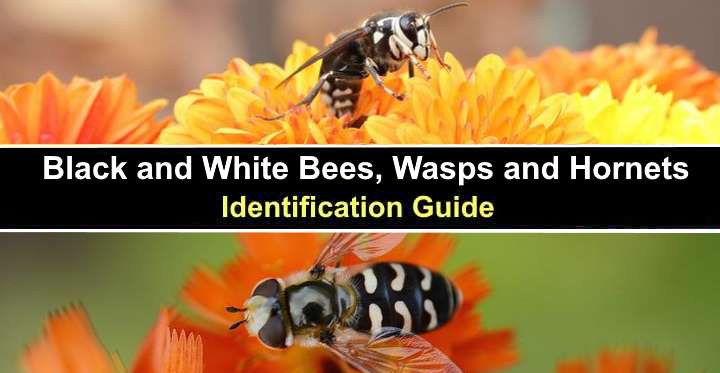
Black and white bees are sometimes mistaken for the bald-faced hornet—a type of black wasp with white markings. However, several species of bees have black furry bodies with white stripes. Additionally, there are a few types of black and white wasps, one of which is the feared bald-faced hornet.
Knowing how to identify black and white bees, wasps, and hornets is vitally important. Bees tend to display less aggressive behavior and wasps and only sting when they feel provoked. On the other hand, the bald-faced hornet with its shiny black body, white stripes, and white face is more aggressive and will sting multiple times if you get too close to its nest.
This article is an identification guide to species of black and white bees. You will also find out how to tell the difference between the bald-faced hornet and black bees or wasps.
Wasps vs. Hornets vs. Bees
Bees, wasps, and hornets are winged insects in the order Hymenoptera. Bees differ from wasps because they are fuzzy creatures with striped yellow or black bodies. Wasps typically have hairless bodies, a slenderer appearance, and a thin waist. Hornets are a species of wasp but are significantly larger and more aggressive.
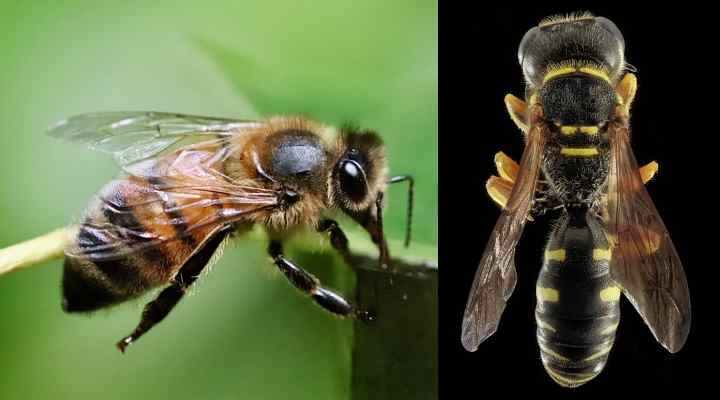
Close up pictures of a honey bee (left) and a wasp (right)
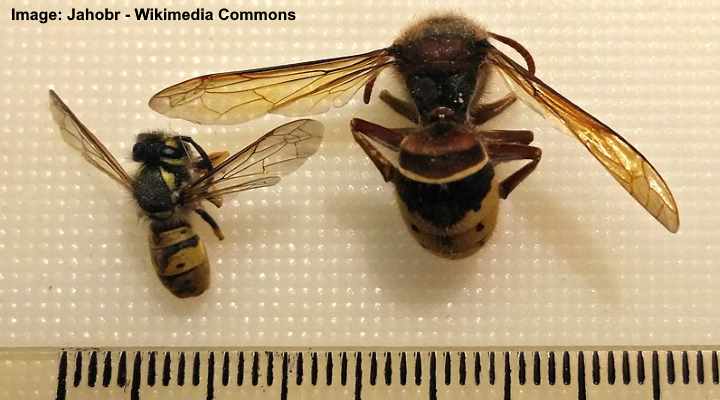
Size comparison of wasp (left) and hornet (right)
Bees, hornets, and wasps have certain characteristics they hold in common. For example, most species of these flying insects can sting. However, bees only sting once, and then they die. Unfortunately, swarms of wasps and hornets can sting multiple times. Wasp and bee stings can be dangerous if someone suffers an allergic reaction.
Let’s look in detail at the identifying features of black and white bees, wasps, and hornets. First on the list is the bald-faced hornet. This is the black and white flying, stinging insect that people fear the most.
Bald-Faced Hornet (Dolichovespula maculata)
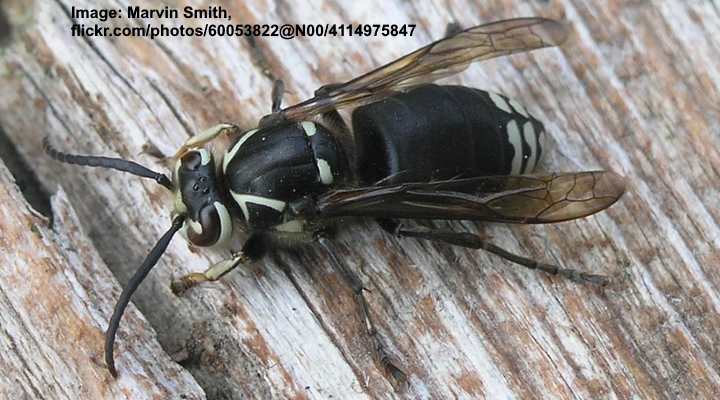
The bald-faced hornet is mostly black with several white markings on its body
The bald-faced hornet is a type of wasp in the genus Dolichovespula. Related to the yellowjacket, the black and white wasp has a jet-black body and a mostly white face. The giant, aggressive wasp has small white dots behind its head and three white stripes at its tail end.
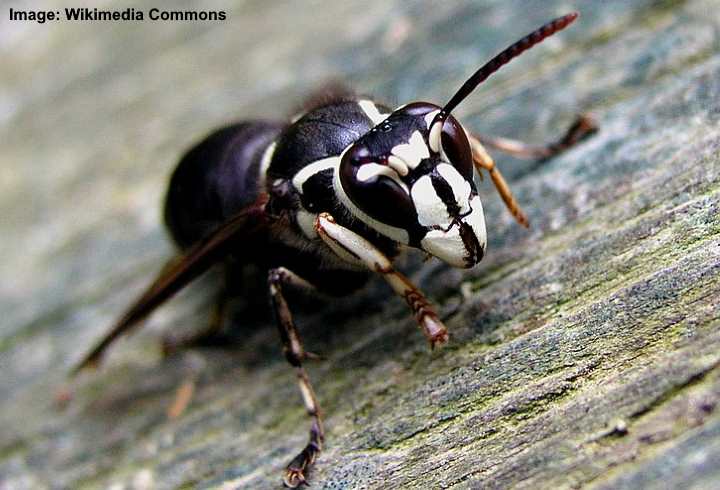
A close up picture of the white and black face of the bald-faced hornet
Like most wasps, the bald-faced hornet has a flattened head, rounded thorax, and oval abdomen. Its white and black face has two kidney-shaped compound eyes and thick segmented antennae. Overall, the large black and white wasp has a smooth, mostly black body.
The bald-faced hornet is not a true hornet in the genus Vespa. Instead, the giant black and white insect gets its name from its size, aggressive hornet-like behavior, and bald-faced head. The adult black and white wasp can measure up to 1” (25 mm) long, double the size of the related yellowjacket.
Bald-faced hornets are black and white social wasps living in large, globe-shaped nests. The gray, papery ball-like nests are usually in tree canopies high above the ground. Sometimes, the wasp nests are found on buildings. So, if you notice many large black and white insects flying around your yards, you may have a bald-faced hornet nest nearby.
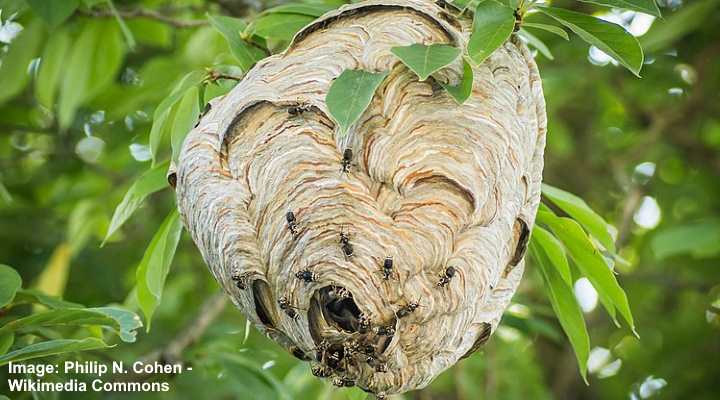
Bald-faced hornets nest
With its black body, smooth white face, and ivory white abdominal markings, the bald-faced hornet goes by other names. For example, it can be called the white-tailed hornet, white-faced hornet, bald-faced wasp, bull wasp, and spruce wasp.
The bald-faced hornet is primarily found in the eastern United States and Canada. However, it’s most common in the southeastern states, where it inhabits forested and urban areas.
Bald-faced hornets pose a threat to humans if you wander too close to the nest. In addition, the large black wasps aggressively defend their nest and will sting repeatedly. Therefore, if you discover a hornet or wasps’ nest, it’s best to call professionals to remove the hornets and eliminate the infestation.
Black and white hornet identification
A bald-faced hornet is identified by its shiny black body, ivory-white face with black patches, and two V-shaped markings on its thorax. In addition, you will notice three horizontal stripes at the end of its black abdomen. Additionally, the wasp has translucent brownish-black wings, two large antennae, and creamy-white forelegs.
Signs of hornet infestation
The classic sign there are bald-faced hornets nearby is increased wasp activity. In addition, you may notice more than usual black bee-like insects buzzing around your yard. Also, papery, globular nests high up in trees or under a building’s overhang could signify a hornet infestation.
Black and White Bees (With Pictures)
Black and white bees pose less of a threat than bald-faced hornets. Here is a list of species of black bees with white markings. Descriptions and pictures of the bees will help identify the species of flying insects.
Ashy Mining Bee (Andrena cineraria)

The ashy mining bee is identified by its black and white-gray furry body
The ashy mining bee is a black bee with two bands of whitish-gray hairs across its thorax and a black, shiny abdomen. The black and white fuzzy insect also has tufts of gray-white hairs on its face. This small black and white bee measures 0.6” (15 mm) long.
Also called the gray mining bee or Danubian miner, the tiny bee gets its name from its habit of making burrow nests. The solitary bees tend to nest in lawns, parklands, flower beds, and orchards. It’s a relatively docile bee species that rarely harms humans.
Ashy mining bees are generally found in coastal areas, open woodlands, and gardens. The black and white bees are important pollinators and usually feed on nectar from fruit tree flowers.
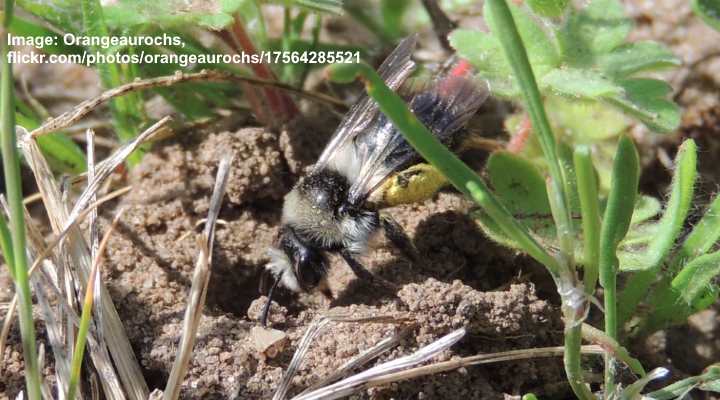
An ashy mining bee carrying pollen into its nest in the sand
Black and white bee identification
The ashy mining bee is identified by its oval black abdomen, black and white fuzzy thorax, and small black head with tufts of white hairs.
Black and white bee habitat
Sunny places with sandy soil, including moorlands, coastal areas, open woodlands, parks, gardens, and urban areas.
Square-Spotted Mourning Bee (Melecta luctuosa)
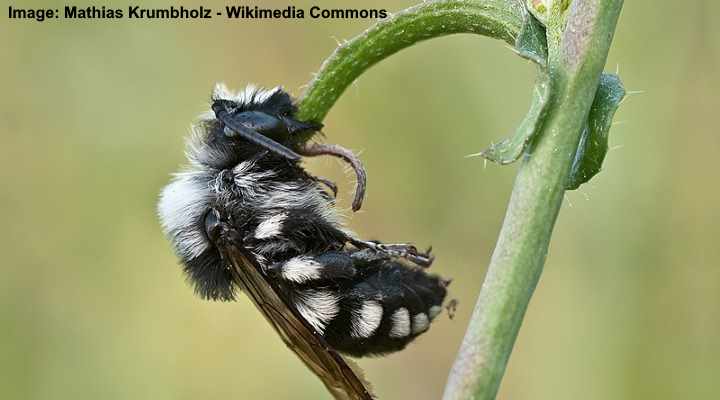
The square-spotted mourning bee has a furry black body with white patches
The fuzzy square-spotted mourning bee is primarily black and has patches of white hairs along its abdomen. From a distance, the small bee looks like a furry black insect with white spots. The white-spotted black bees measure 0.47” to 0.55” (12 – 14 mm) long.
Other identifying features of the square-spotted mourning bee are its translucent dark brown pair of wings, thick, black antennae, and kidney-shaped black compound eyes.
Black and white bee identification
The square-spotted mourning bee is a furry black bee with tufts of white hairs on its abdomen, thorax, and head.
Black and white bee habitat
The habitat of the square-spotted mourning bee is sandy areas, forests, and hedges in Europe.
White-Banded Digger Bee (Amegilla quadrifasciata)
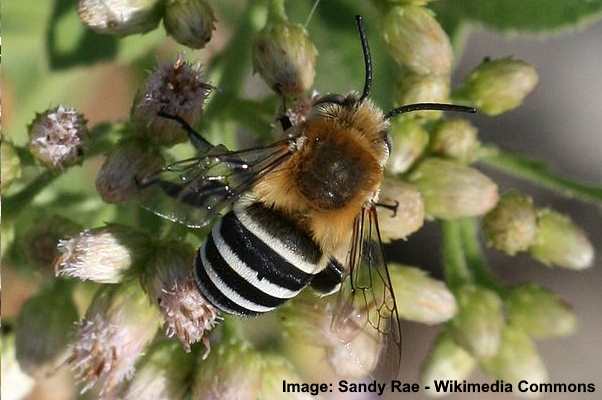
The white-banded digger bee has black and white striped abdomen with yellow hairs on its thorax
The white-banded digger bee has a smooth black abdomen with several white bands traversing it. The black and white bee has a furry thorax and head covered in fine yellowish hairs. This digger bee species also has black and white legs. The white banded digger bee measures 0.35” – 0.47” (9 – 12 mm) long.
The small black and white striped bee is found throughout Europe and as far east as Japan. The pollinating insect feeds on nectar from several species of flowering plants, including legumes, borage, and salvia.
As their name suggests, these white-banded bees dig tunnels in the ground. The solitary bees don’t live in colonies. Instead, the females lay eggs in the burrows, where they store nectar and pollen to feed the larvae.
Black and white bee identification
The white-banded digger bee is easily recognizable due to its smooth black abdomen and white stripes. This contrasts with its hairy, orange-grown head and thorax.
Black and white bee habitat
Forests, farmlands, shrub lands.
Bellflower Resin Bee (Megachile campanulae)
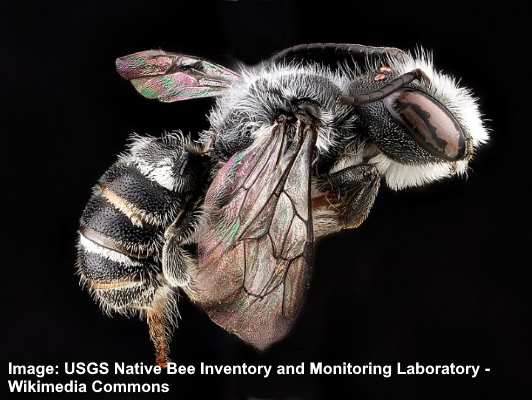
The black and white bellflower resin bee is an important pollinator
The bellflower resin bee is a hairy black bee with slender bands of white hairs around its abdomen. The bee has an overall grayish appearance because of the whitish-gray hairs covering its black body. Other identification features are its oval compound eyes on the side of its head and two curved antennae.
The medium-sized black and white hairy bees measure 0.4” to 0.47” (10 – 12 mm) long. Resin bees are found throughout the eastern part of North America. In addition, the furry bees are found from Ontario to Florida and as far west as Texas and Minnesota.
Bellflower resin bees are important pollinators for various crops and flowers. As the name suggests, they mainly frequent bellflowers (Campanula). However, they also feed on nectar from evening primrose, catmint, coneflower, verbena, and lobelia flowers.
Black and white bee identification
The bellflower resin bee is a native North American black bee with bands of white hairs across its abdomen and a black head covered in white hairs.
Black and white bee habitat
They feed on many species of flowers in gardens, parks, and woodlands.
Digger Bees (Anthophorini)

The large digger bees have black body covered in white hairs
Anthophorini is a large group of solitary bees called digger bees, some of which are black bees covered in white hairs. The large bees are recognized by their white or yellow facial markings, short grayish hairs, and short wings. However, compared to other black and white bees, digger bees are large, growing up to 1.1” (30 mm).
One of the black and white bees in the Anthophorini tribe is the chimney bee (Anthophora abrupta). The robust, stout docile bee has a black segmented body and thorax covered in whitish-yellow hairs. These black and creamy-yellow bees look like small bumble bees.
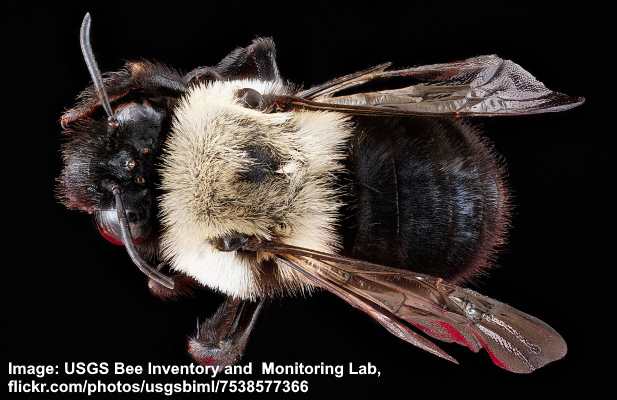
The chimney bee (Anthophora abrupta)
As the name suggests, digger bees tunnel holes in the ground to form nests. The chimney bee also creates chimney-like structures or turrets from mud, making the nest easily recognizable.

A female chimney bee builds a chimney of mud at the entrance to her nest
Black and white bee identification
The identifiable features of a digger bee are its hairy thorax and abdomen, spindly forelegs, robust hind legs, and making a high-pitched whining sound as it buzzes around flowers.
Black and white bee habitat
Feeds on the nectar from most flowers.
White-Tailed Bumblebees (Bombus lucorum)
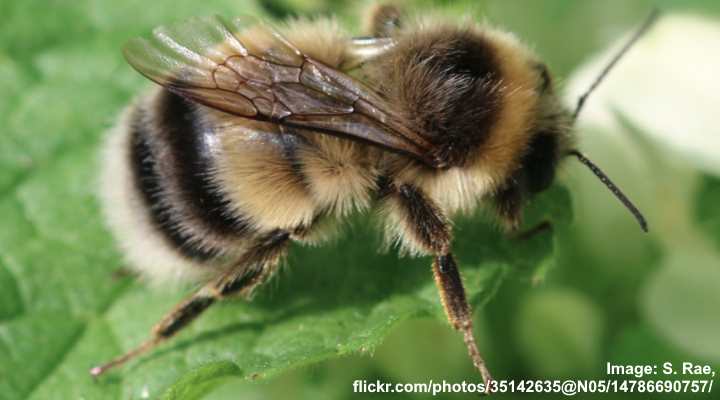
The furry black and yellow white-tailed bumblebee is identified by its white end
White-tailed bumblebees are black and yellow-orange furry bees with a distinctive white tail end. In addition, the large, barrel-shaped bees have a characteristic yellow band across the abdomen and thorax. The black, yellow, and white queen bees measure 0.71” to 0.87” (18 – 22 mm), and the worker between 0.47” and 0.71” (12 – 18 mm).
White-tailed bumblebees nest in the ground and are typically the first to emerge after hibernation. The harmless, docile creatures feed on flowers like crocus, mahonia, bluebells, rhododendrons, thistles, and campanula.
Black and white bee identification
White-tailed bumblebees are furry black and yellow bees with an easily recognizable white posterior. There are no discerning characteristics between the three species of white-tailed bumble bees.
Black and white bee habitat
Usually found in gardens, woodland edges, grasslands, farmlands, and coastal areas.
Black and White Wasps (With Pictures)
The bald-faced hornet is the most common species of black and white wasp. However, there are a few other types of black wasps with white markings. Here are three species.
Ichneumon Wasp (Coelichneumon navus)

The Ichneumon wasp has a black slender body with white markings, as well as black and white legs and antennae
The Ichneumon wasp, Coelichneumon navus, is easy to recognize due to its long, slender black abdomen with white markings on its body. Looking at pictures of this white-spotted black wasp, you’ll notice the black antennae have white bands, and there is a distinctive white V-shape on its abdomen.
The thin-bodied black and white banded wasp measures 0.47” to 0.98” (12 – 25 mm) long. Other identifying features of the wasp are its black and white legs, creamy white rings around the black eyes, large translucent wings, and long, segmented antennae.
The Ichneumon wasp is a type of parasitic wasp that attacks caterpillars, especially fall armyworms and webworms. The females lay eggs on the back of the caterpillars, and the larvae eat the caterpillars after hatching. This habit makes the black and white wasp a beneficial insect for pest control.
Black and white wasp identification
The distinctive slender black wasp is easily recognizable due to the white bands on its legs and antennae. Also, look for the characteristic V marking on its thorax and white-ringed eyes.
Black and White Digger Wasp (Bicyrtes quadrifasciatus)
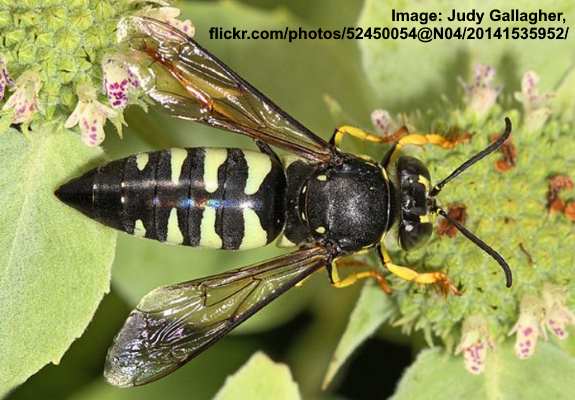
The black and white digger wasp has a smooth black body with creamy-white to yellowish-green marking on its abdomen
The hairless black and white digger wasp has four distinctive creamy white to greenish-yellow bands on its abdominal segments. Its six legs are a contrasting golden yellow color, and the wasp has amber or grayish wings. The solitary wasps grow 0.66” to 0.74” (17 – 19 mm) long.
The black and white digger wasp is usually found in sandy sites and urban areas. The large wasps feed on the nectar from various flowers. However, female wasps will catch and kill small insects and put them in their ground nest for the wasp larvae to feed on.

Black and white digger wasp nest in the sand
Black and white wasp identification
The black and white digger wasp is easy to identify due to its bright yellow legs, yellowish-white or greenish-white abdominal bands, and bright yellow markings on its face.
Euodynerus Megaera
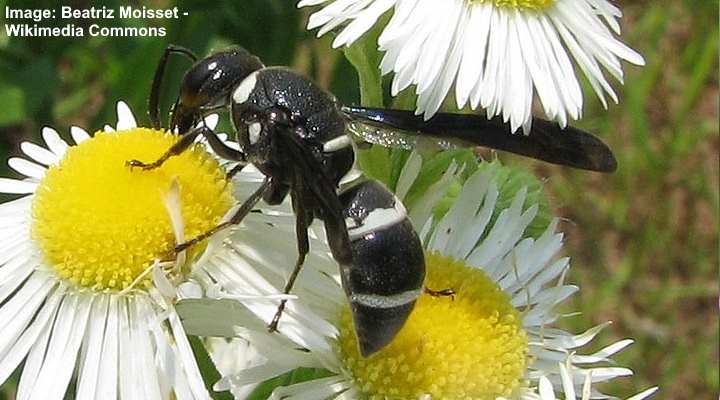
The Euodynerus megaera wasp has a smooth black body with white bands on the abdomen and thorax
Euodynerus Megaera is a slender jet-black stinging wasp with two white bands across its abdomen and white markings on its thorax. Other identifying features of this wasp are its shiny black head, crooked antenna, and black wings. Like most wasps, this black and white species has a thin waist between the abdomen and thorax.
Related articles:
- Black and Yellow Bees, Wasps and Hornets – Identification Guide
- Types of Bees – Identification Guide
- Insects That Look Like Bees – Identification
